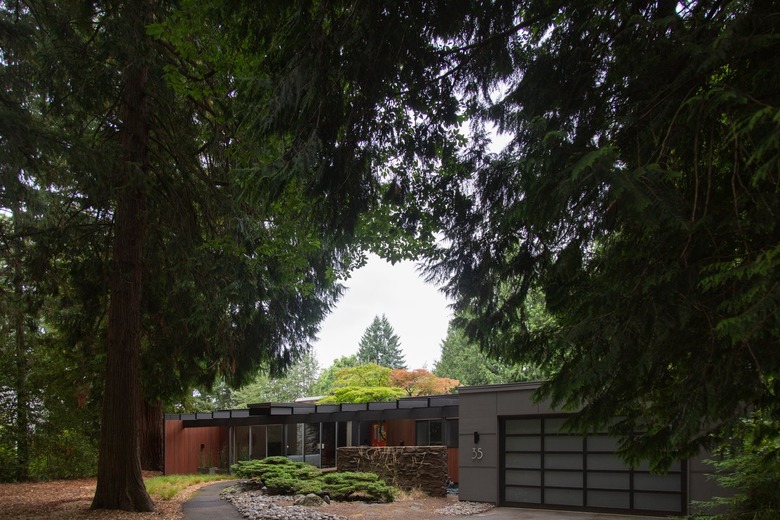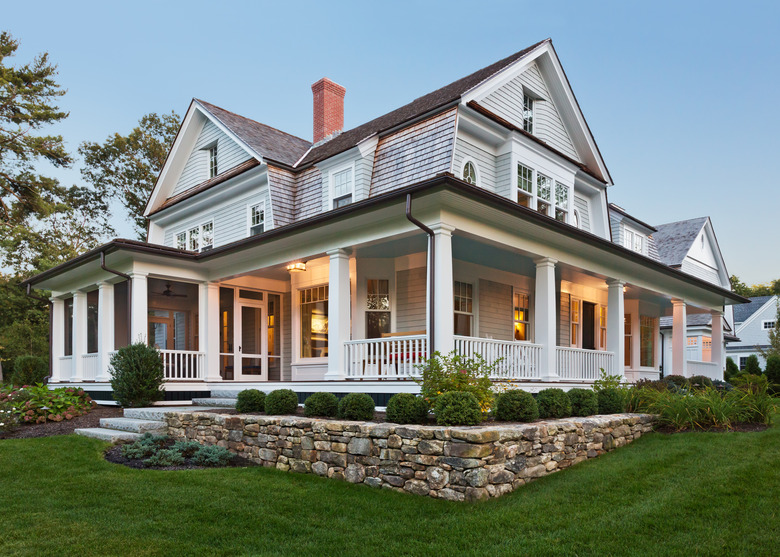How To Choose The Best Shrubs For Your Landscape
There's a gardening cliché that says shrubs—along with trees—are the bones of a landscape. Like most clichés, there is some truth in that statement because once you choose the best shrubs for your landscape, the rest seems to fall into place.
Shrubs are perennials, which means they continue to grow year after year. Generally, they have multiple woody stems that grow from the root—unlike a tree, which has one trunk. Many of the best shrubs have rounded shapes that add a softness to your landscaping. They don't grow as tall as trees, although some can reach 10 to 13 feet in height.
Some shrubs are deciduous, and some are evergreen. There are shrubs with short-lived blooming seasons in springtime and others that bloom throughout the summer and into the fall. Some shrubs even bloom in winter. Blooms come in many colors, and there are also different hues and shades of foliage. Some shrubs are at their best at the first signs of spring, while others don't become showy until the fall.
How Shrubs Are Used
If you were starting a landscape from scratch, you could not go wrong by putting the best shrubs in place first and then filling in with other plantings. When used as foundation plants, evergreen shrubs provide year-round color as well as texture around the foundation of the house. It's best to choose low-growing species so that they don't get out of hand and block the windows of the house.
Some types are dense and thick enough to provide privacy screens, including many shrub rose varieties. Shrubs are often used as backdrops for other plants in a border planting or on a slope. A rounded shrub with colorful foliage can complement colorful perennial and annual blooms.
Many homeowners use shrubs as specimen plants. These are plants that can stand on their own and become the focal point of a yard or garden. Hydrangeas, azaleas and some rose shrubs are popular choices for specimen plants, but there are dozens more that would qualify.
Choosing the Best Shrubs
The amount of sun or shade that your site receives, the soil conditions, your local climate and how much work you want to put into maintaining your plants all play a part in selecting the best shrubs for your landscape. Use this information to match the plant requirements from the shrubs you select. Although you're often able to glean some information from the packaging on plants at garden centers, it's always helpful to ask for tips on how to care for your chosen shrubs from a knowledgeable salesperson at a local nursery.
One school of thought when it comes to choosing shrubs is to start with the plants that are native to your area. These are plants that have evolved and adapted to local conditions, such as the climate, soil type and even how to fend off diseases. You can get plant lists by contacting your county extension office of the Cooperative Extension System, which is a U.S. Department of Agriculture (USDA) program that works with local governments and land grant universities to provide information on gardening.
Chances are that at least some of the plants you choose won't be indigenous to your area. That's because you can buy plants online, and local home centers and garden centers source shrubs from all over the country. Whittle down the choices by consulting the USDA plant hardiness zone map, which divides the U.S. and Canada into 13 zones based on their average minimum winter temperature. Newer maps divide each zone into two, sub-zones "a" and "b." The map helps you decide which plants will survive best in your garden.
Planting and Maintaining Shrubs
Shrubs can last for years, and well-draining soil is best for most of them. If you are not sure about your soil, dig a hole about 1 foot wide and 1 foot deep and fill it with water. Well-draining soil will empty between 10 and 30 minutes. If necessary, you can add organic matter to the native soil, such as compost or peat moss, to improve drainage.
Before you plant, it is also a good idea to have the soil tested. Some garden centers can perform soil tests that measure the pH of the soil as well as what nutrients are contained in the sample. The county extension office can also perform soil tests. If you're feeling in a scientific mood, you can test the pH of the soil yourself using a soil test kit.
A pH test measures the balance of the soil in terms of its acidity and alkalinity. It is expressed as a number between one and 14. A result below seven means the soil is on the acidic side. Shrubs like acidic to neutral soil that registers around seven. There are soil amendments, such as lime to raise the pH of acidic soil and sulfur to lower the pH for alkaline soil, that can move the soil toward the neutral range.
As far as when it's best to plant your shrubs, check the requirements for the plants you select, but it is usually best to plant shrubs in the fall. The soil is still warm at that time of year, so the shrubs can develop a strong root system.
Most shrubs are not fussy, but they do require some maintenance to keep their shape and to promote blooms if they are a flowering variety. Many plants need pruning at least once a year. Spring-flowering shrubs are pruned when the blooms die back. Summer-flowering shrubs and those that don't flower are usually pruned in early spring.
Top 10 Best Shrubs
Though there are thousands of types of shrubs, gardeners keep coming back to some tried and true favorites. These 10 shrubs will add show-stopping blooms to your yard or keep some much-needed color in your landscaping in the dead of winter when the tree limbs are bare and there's inches of snow or ice on the ground.
- White Rugosa Rose (Rosa rugosa 'Alba,' zones 3 through 8): This tough shrub rose works as a specimen plant or can be planted to form a dense barrier. It can grow up to 6 feet tall and 5 feet wide. Once established, it requires minimal watering.
- Annabelle Hydrangea (Hydrangea arborescens 'Annabelle,' zones 3 through 9): There are over 70 hydrangea species worldwide, but only about six are regularly grown in the U.S. Annabelle has large, showy, white blooms that last throughout the summer. The plant can reach 5 feet tall and wide. It provides a great backdrop for smaller colorful blooms or as a border planting. This shrub prefers partial shade in very hot climates.
- Tango Weigela (Weigela florida 'Tango,' zones 4 through 8): This compact shrub only reaches 2 to 3 feet tall and wide, making it a good candidate for foundation planting. The rose-colored flowers last a long time throughout the summer, and they attract butterflies. This shrub requires regular watering.
- Andorra Juniper (Juniperus horizontalis 'Andorra,' zones 3 through 9): This compact, ground-cover evergreen shrub works well in borders and rock gardens. It only reaches about 12 inches in height but can spread up to 6 feet. The foliage takes on a bronze-purple tint in winter for seasonal interest. Junipers are bird-friendly and deer-resistant, and they have low water requirements.
- Red Chokeberry (Aronia arbutifolia 'Brilliantissima,' zones 4 through 9): This shrub produces white flowers in the spring and then bright-red foliage and berries in the fall. It can grow 6 to 8 feet tall and 3 to 4 feet wide. It does not mind boggy soil, and it does well near streams and ponds.
- Spring Glory Forsythia (Forsythia x intermedia 'Spring Glory,' zones 3 through 9): One of the first bloomers of spring, this plant produces bright-yellow flowers. The blooms give way to green foliage that serves as a backdrop for other plants. It can reach 10 feet in height.
- Red-Twig Dogwood (Cornus sericea 'Cardinal,' zones 3 through 8): Although it produces white flowers in the spring, it isn't until fall and winter when this shrub comes into its own with bright-red stems. It can grow 9 feet tall with a 12-foot spread. This is one shrub that does not mind heavy, wet soil.
- Arrowwood Viburnum (Viburnum dentatum, zones 2 through 8): In spring, viburnum produces tiny, white flowers. The foliage turns from green to burgundy in the fall. This shrub can reach 10 feet high with an equal spread and is tolerant of drought and hot weather. Use it as a specimen plant or grouped together to form a privacy screen.
- Dwarf Burning Bush (Euonymus alatus 'Compactus,' zones 4 through 8): The bright-red fall color makes this a great accent plant when grouped with evergreen plants. It can reach up to 10 feet in height with an equal spread and can make a hedge that changes with every season.
- Karen Azalea (Rhododendron x 'Karen,' zones 4 through 9): Reaching only 2 to 4 feet in height and producing an array of lavender-purple flowers in spring, this azalea is one of the most popular foundation plants. When planted in borders, group a number together for a stunning display.


